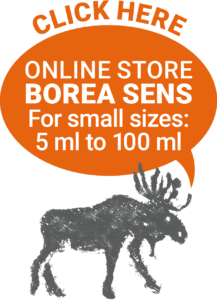LARCH TAMARACK HYDROSOL
The quality of a HYDROSOL
The quality of a hydrosol depends on the plant and the soil in which the plant grew. It also depends on the quality of the air, the climatic conditions during the growth of the plant, the precise time chosen to collect the plant, the waiting time before distillation and, of course, the quality of the water.
BoreA Canada is able to meet all these quality criteria thanks to its very favourable geographical location, in the heart of the wild boreal forest, far from homes and pollution and where the water, land and air are pure.

Latin Name: Larix laricina
French Name: Mélèze Laricin
English Name: Larch Tamarack
Family: Pinaceae
Origin: Quebec, Canada
Harvest time: July to September
Distilled Part: Twigs & Needles
ORIGIN
The tamarack or American larch is also called a ‘red spruce’ in the vernacular of our French ancestors. Because the different resinous trees were misunderstood, they were all grouped with the same name. Today we know that these trees are part of the Pinaceae family and not the Epiceae family, like black or white spruce. The peculiarity of this native tree is that it is the only Canadian conifer to lose its needles at the end of autumn. But before losing its needles, they will change from green to a flamboyant golden yellow. Thus, adding to the many vibrant autumnal colours of our beautiful Canadian forests.
The larch is found all over Canada. The terrain conducive to its development is moist, light and well-drained soils, but it does not tolerate much shade, which would explain its presence in sphagnum peat bogs. Under ideal conditions, it can reach up to 22 meters in height after twenty years of growth. It grows three times faster than a fir or spruce tree.
Its bark is grey when it is young and turns into small reddish brown scales over time. The larch’s cones are less than 2 cm long and can stick to the tree for a year. During flowering, the flowers of the male cones are yellow and those of the female cones are pink. Its needles are supple and soft to the touch. They are light green and measure 2 to 5 cm in length. They grow back every spring in groups of 30 to 40 per cluster.
Its hard and heavy wood is resistant to moisture and makes it an excellent choice for outdoor use. It is used to make patios, shingles, stilts, boats, and canoe skins, as well as studs, poles and railroad ties. In the past, barn floors were made with this essential wood, because its durability allowed it to resist the hooves and urine of horses!
The larch is the official emblem tree for the Northwest Territories.
HISTORY
Several Amerindian tribes made a decoction of larch needles along with the cambium to help with colds, fever and the flu. Young branches were infused for their laxative power. A poultice made from the inside of the bark plus its leaves, dried up draining wounds and stopped hemorrhaging. This tree possessed many benefits including those of helping in cases of rheumatism, tuberculosis, anemia and even gonorrhea.
Recommendations: Essential oils and hydrosols are wonderful for the well-being of humans, animals, insects and plants. There are many books on the subject of aromatherapy and they should be referred to for the proper and safe use of essential oils and hydrosols. We also recommend that you consult an aromatherapy professional, who will be able to target the aromatic molecules of essential oils or hydrosols and their biochemical groupings, thereby increasing the effectiveness of your care.
The information provided on this website does NOT in any way constitute a recommendation for the care or treatment of any particular medical condition or disease.
We do not add any preservatives to our hydrosols, so they should be stored in a cool, dry place, away from light and air, in order to keep them for 1 to 3 years.
References
-
Franchomme, P., Jollois, R,. Pénoël, D., L’aromathérapie exactement, Encyclopédie de l’utilisation thérapeutique des huiles essentielles, fondements, démonstration, illustration et applications d’une science médicale naturelle, Bayeux, Éditions Roger Jollois, 2001.
-
Bioresour Technol. 2009 Jan;100(1):465-70. doi: 10.1016/j.biortech.2007.11.060. Epub 2008 Jan 4, https://www.ncbi.nlm.nih.gov/pubmed/18178080, Variations in insecticidal activity and chemical compositions of leaf essential oils from Cryptomeria japonica at different ages.
-
https://www.florelaurentienne.com/flore/Groupes/Spermatophytes/Gymnospermes/010_Pinace es/02_Larix/laricina.htm
-
MOERMAN Daniel E., Native American Ethnobotany, timber press, Portland, Oregon, 1998.
-
http://espacepourlavie.ca/flore-biodome/meleze-laricin-tamarac
-
https://arbrescanada.ca/ressources/arbres-du-canada/meleze-laricin-larix-laricina/
-
https://quebecwoodexport.com/produits/bois-resineux/essences/meleze/
-
https://afsq.org/information-foret/nos-arbres/meleze-laricin/

